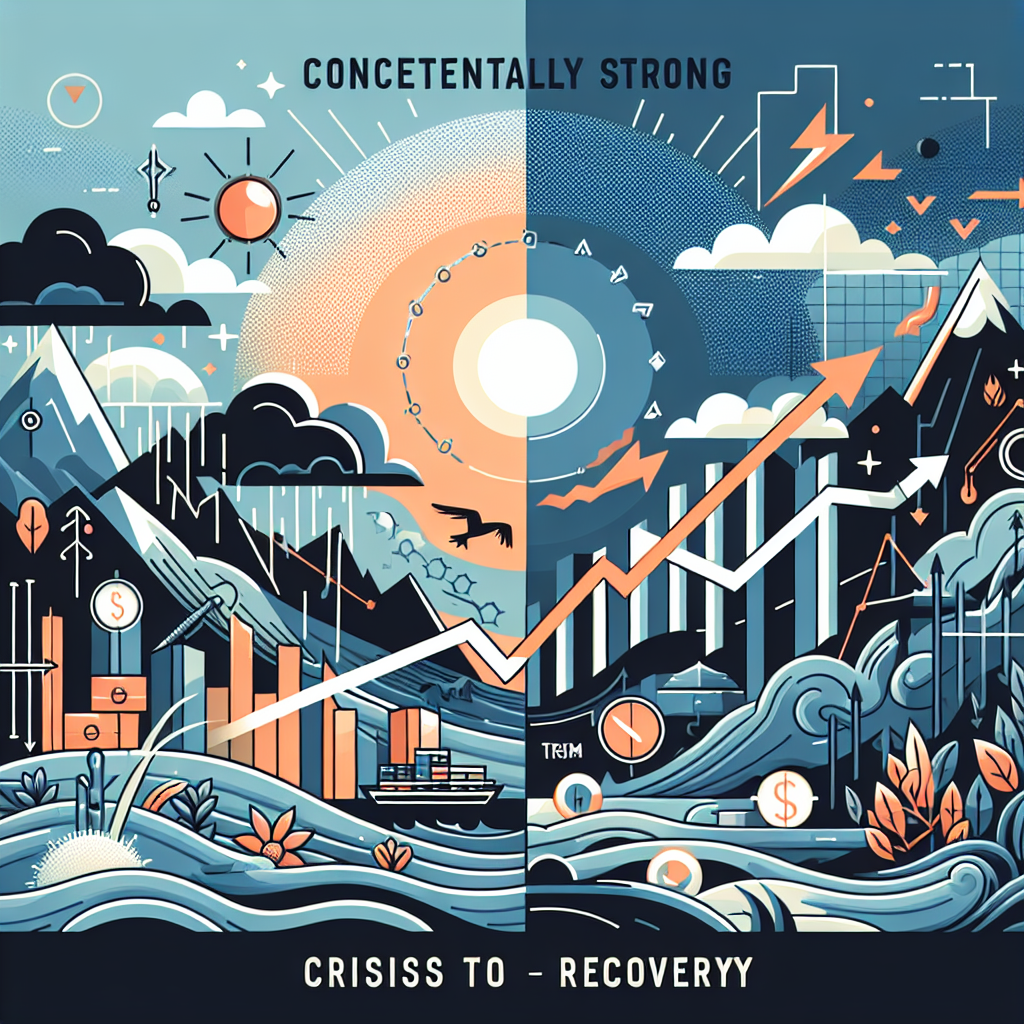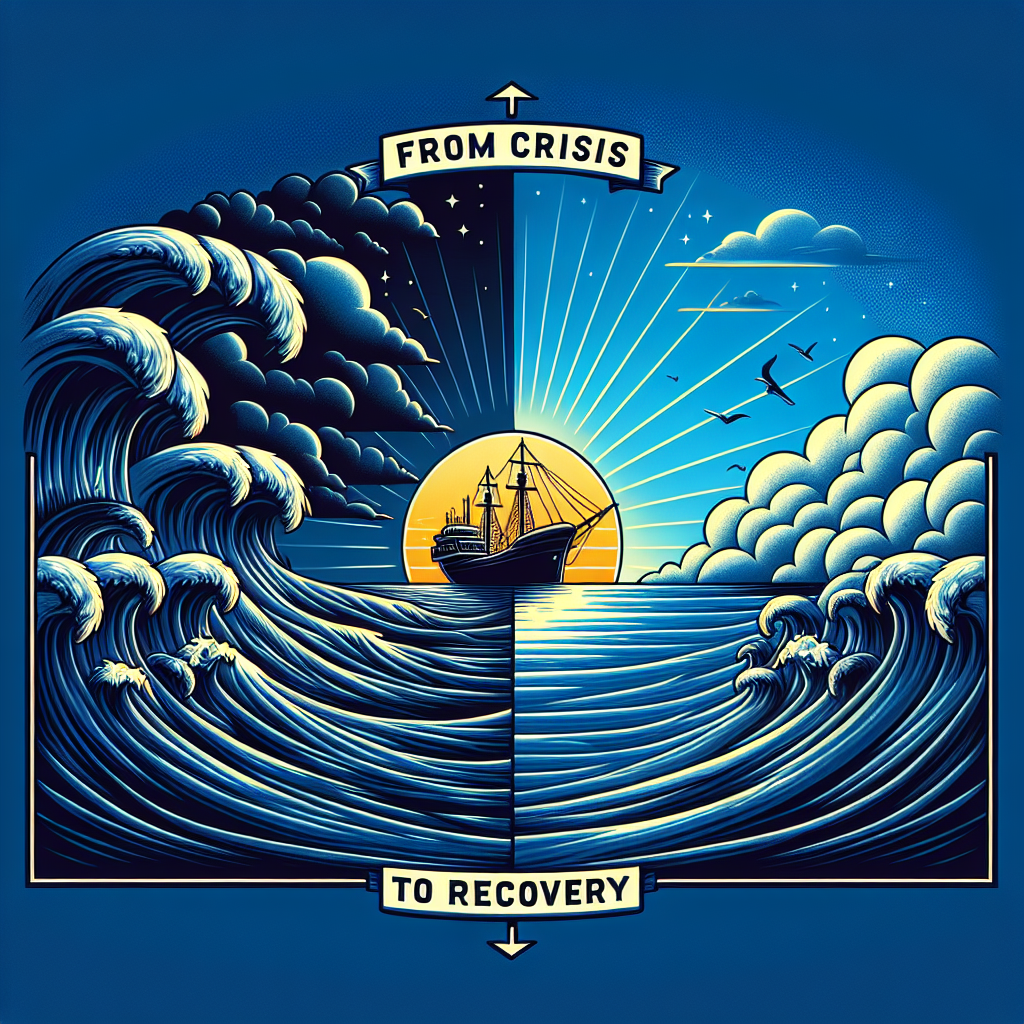Your cart is currently empty!
Tag: Crisis

From Crisis to Recovery: Managing Business Continuity in Uncertain Times
In today’s fast-paced and ever-changing business landscape, organizations are constantly faced with a myriad of challenges that can threaten their ability to operate effectively. From natural disasters to economic downturns to global pandemics, the list of potential crises that can impact a business is extensive.In times of uncertainty, it is crucial for organizations to have a robust business continuity plan in place to ensure that they can continue to operate efficiently and effectively despite any disruptions that may arise. From crisis to recovery, managing business continuity is essential for ensuring the long-term success and sustainability of a business.
One of the key components of a successful business continuity plan is risk assessment. By identifying potential risks and vulnerabilities, organizations can develop strategies to mitigate these risks and ensure that they are prepared to respond effectively in the event of a crisis. This may involve implementing backup systems, creating emergency response plans, and establishing communication protocols to keep stakeholders informed.
Another important aspect of managing business continuity in uncertain times is ensuring that employees are well-trained and prepared to respond to emergencies. This may involve conducting regular training exercises, providing access to resources and support, and establishing clear lines of communication to ensure that everyone knows their role in the event of a crisis.
In addition to preparing for potential crises, it is also important for organizations to have a plan in place for recovery and restoration. This may involve assessing the impact of the crisis on the business, identifying areas that need to be addressed, and developing a strategy for returning to normal operations as quickly as possible. By having a clear roadmap for recovery, organizations can minimize downtime and ensure that they are able to resume operations smoothly.
Ultimately, managing business continuity in uncertain times requires a proactive and strategic approach. By identifying potential risks, preparing for emergencies, and developing a plan for recovery, organizations can ensure that they are well-equipped to navigate any challenges that may come their way. In doing so, they can safeguard their business, protect their employees, and maintain their reputation in the face of adversity.

From Crisis to Recovery: How Business Continuity Plans Can Save Your Company
In today’s unpredictable world, businesses face a multitude of risks that can disrupt their operations at any moment. From natural disasters to cyber attacks, the threat of a crisis looms large for companies of all sizes. In order to weather these storms and ensure the continuity of their operations, businesses must have a solid business continuity plan in place.A business continuity plan is a proactive strategy that outlines how a company will continue to operate during and after a crisis. It involves identifying potential risks, assessing their impact on the business, and developing strategies to mitigate those risks. By having a comprehensive business continuity plan in place, companies can minimize downtime, protect their assets, and maintain the trust of their customers and stakeholders.
But why is having a business continuity plan so important? The answer lies in the potential cost of a crisis. According to a study by the Disaster Recovery Preparedness Council, 73% of companies that experienced a major data loss were unable to recover, and 43% never reopened. The financial implications of a crisis can be catastrophic, with lost revenue, damaged reputation, and legal liabilities all on the line.
Having a business continuity plan can save your company from these dire consequences. By being prepared for a crisis, businesses can minimize the impact on their operations and bounce back more quickly. This not only protects the company’s bottom line but also ensures the safety and well-being of its employees and customers.
So, what should a business continuity plan include? Key elements of a successful plan include:
1. Risk assessment: Identify potential risks that could disrupt your business, such as natural disasters, cyber attacks, or supply chain disruptions.
2. Business impact analysis: Determine the potential impact of these risks on your operations, including financial losses, reputational damage, and regulatory compliance issues.
3. Recovery strategies: Develop strategies to minimize downtime and recover quickly from a crisis, such as backup and recovery systems, remote working capabilities, and communication plans.
4. Testing and training: Regularly test your plan to ensure it is effective and train your employees on their roles and responsibilities during a crisis.
By investing in a business continuity plan, companies can protect themselves from the unexpected and ensure their long-term success. From crisis to recovery, having a solid plan in place can make all the difference in saving your company from disaster.

Preparing for the Unexpected: Steps to Ensure Business Continuity in Times of Crisis
In today’s fast-paced and unpredictable business environment, it is crucial for companies to be prepared for the unexpected. From natural disasters to cyber attacks, there are a multitude of potential threats that can disrupt business operations and put a company’s viability at risk. In times of crisis, being able to maintain business continuity is essential for ensuring that a company can weather the storm and emerge stronger on the other side.One of the key steps in preparing for the unexpected is to create a comprehensive business continuity plan. This plan should outline the steps that need to be taken in the event of a crisis, including who will be responsible for implementing them and how communication will be handled. It should also identify the critical functions of the business and prioritize them to ensure that they can be maintained even in the face of a crisis.
Another important aspect of preparing for the unexpected is to regularly review and update the business continuity plan. As the business environment changes and new threats emerge, it is essential to ensure that the plan remains relevant and effective. This can be done through regular testing and simulation exercises, which can help to identify any weaknesses in the plan and allow for adjustments to be made.
In addition to having a solid business continuity plan in place, companies should also take steps to mitigate the risks that could lead to a crisis. This can include implementing robust cybersecurity measures to protect against cyber attacks, as well as investing in physical security to safeguard against natural disasters or other physical threats. By taking proactive measures to prevent crises from occurring in the first place, companies can greatly reduce the impact of any unexpected events that do occur.
Finally, in times of crisis, it is essential for companies to communicate effectively with their stakeholders. This can include employees, customers, suppliers, and the media. By keeping these groups informed and updated on the situation, companies can help to maintain trust and confidence in their ability to weather the storm. Clear and transparent communication can also help to mitigate any potential reputational damage that may result from a crisis.
In conclusion, preparing for the unexpected is essential for ensuring business continuity in times of crisis. By creating a comprehensive business continuity plan, regularly reviewing and updating it, mitigating risks, and communicating effectively with stakeholders, companies can greatly increase their chances of successfully navigating through any unexpected events that may arise. By taking these steps, companies can not only survive a crisis but also emerge stronger and more resilient on the other side.

Building Resilience: How Disaster Recovery Plans Can Help Businesses Bounce Back After a Crisis
In today’s fast-paced and unpredictable world, disasters can strike at any moment, leaving businesses vulnerable and struggling to recover. From natural disasters like hurricanes and earthquakes to cyberattacks and data breaches, the threat of a crisis is always looming. However, with a well-thought-out disaster recovery plan in place, businesses can build resilience and bounce back quickly after a crisis.Disaster recovery plans are essential for businesses of all sizes, as they provide a roadmap for how to respond and recover in the event of a disaster. These plans outline the steps that need to be taken to protect critical data, systems, and operations, as well as the roles and responsibilities of key personnel during a crisis.
One of the key benefits of having a disaster recovery plan is the ability to minimize downtime and quickly resume operations after a crisis. By having a plan in place, businesses can ensure that critical systems and infrastructure are backed up and can be restored quickly, allowing them to get back up and running as soon as possible.
In addition to minimizing downtime, disaster recovery plans also help businesses protect their reputation and customer trust. In the aftermath of a crisis, customers expect businesses to be transparent and proactive in their response. By having a plan in place, businesses can demonstrate that they are prepared for any eventuality and are committed to minimizing the impact on their customers.
Furthermore, disaster recovery plans can also help businesses save money in the long run. The cost of recovering from a disaster can be significant, from lost revenue and productivity to reputational damage. By investing in a comprehensive disaster recovery plan, businesses can reduce the financial impact of a crisis and ensure that they are able to bounce back quickly.
Building resilience through disaster recovery planning is not just about preparing for the worst-case scenario; it is also about fostering a culture of preparedness and adaptability within the organization. By regularly reviewing and updating their disaster recovery plans, businesses can stay ahead of emerging threats and ensure that they are always ready to respond to any crisis.
In conclusion, disaster recovery plans are essential for businesses looking to build resilience and bounce back quickly after a crisis. By investing in a comprehensive plan, businesses can minimize downtime, protect their reputation, save money, and foster a culture of preparedness within the organization. In today’s uncertain world, having a disaster recovery plan is not just a good idea – it is essential for the long-term success and sustainability of any business.

Case Studies in Business Continuity: Lessons Learned from Companies that Successfully Weathered a Crisis
In today’s fast-paced and unpredictable business environment, companies must be prepared to weather any crisis that comes their way. Whether it’s a natural disaster, cyber attack, or financial collapse, having a solid business continuity plan in place is essential for ensuring the survival of a company in times of crisis.One of the best ways to learn how to navigate a crisis successfully is to study case studies of companies that have done so in the past. By examining the strategies and tactics these companies used to survive and even thrive during a crisis, other businesses can gain valuable insights into how to protect themselves and their employees when disaster strikes.
One such case study is that of Airbnb, the popular online accommodation platform. In 2011, Airbnb faced a major crisis when a host’s home was vandalized by a guest. The incident received widespread media attention and raised concerns about the safety and security of using the platform. In response, Airbnb took swift action to address the issue, implementing a $50,000 guarantee for hosts to cover any damages caused by guests and improving their customer service and support systems.
By taking proactive measures to address the crisis head-on, Airbnb not only managed to retain the trust of its users but also emerged stronger than ever. The company’s quick and decisive response to the crisis demonstrated the importance of being prepared and having a plan in place to deal with unexpected challenges.
Another example of a company that successfully weathered a crisis is Ford Motor Company. In 2008, during the height of the financial crisis, Ford faced the prospect of bankruptcy along with its competitors General Motors and Chrysler. However, Ford’s management team had the foresight to take out a $23.5 billion loan before the crisis hit, allowing the company to weather the storm and avoid the fate of its rivals.
Ford’s ability to anticipate the crisis and take proactive measures to protect its business highlights the importance of strategic planning and risk management in times of uncertainty. By making tough decisions and taking bold actions, Ford was able to emerge from the crisis stronger and more resilient than ever.
In conclusion, studying case studies of companies that have successfully weathered a crisis can provide valuable lessons for other businesses looking to protect themselves in the face of uncertainty. By learning from the experiences of companies like Airbnb and Ford, organizations can develop robust business continuity plans that enable them to navigate any crisis with confidence and resilience. Ultimately, being prepared and having a solid plan in place is key to surviving and thriving in today’s unpredictable business environment.

From Chaos to Recovery: Strategies for Managing a Business Crisis
In the fast-paced world of business, unexpected crises can strike at any moment, throwing even the most well-prepared companies into chaos. From natural disasters to financial scandals, there are countless potential threats that can disrupt the operations of a business and jeopardize its reputation and bottom line.When faced with a crisis, it is crucial for business leaders to act swiftly and decisively to mitigate the damage and steer the company back on track. From chaos to recovery, here are some key strategies for managing a business crisis effectively:
1. Develop a Crisis Management Plan: The first step in preparing for a crisis is to develop a comprehensive crisis management plan. This plan should outline the roles and responsibilities of key personnel, establish communication protocols, and identify potential risks and vulnerabilities. By having a plan in place, businesses can respond quickly and effectively when a crisis occurs.
2. Communicate Transparently: In times of crisis, open and honest communication is essential. Businesses should be transparent with employees, customers, and other stakeholders about the situation and the steps being taken to address it. Clear and timely communication can help build trust and maintain credibility during a crisis.
3. Prioritize Employee Safety: The safety and well-being of employees should always be the top priority during a crisis. Businesses should have protocols in place to ensure the safety of their workforce, whether it be evacuating a building during a natural disaster or providing support for employees facing personal challenges.
4. Assess the Impact: Once a crisis has occurred, it is important to assess the impact on the business and its operations. This includes evaluating the financial implications, reputational damage, and any legal or regulatory issues that may arise. By understanding the full extent of the crisis, businesses can develop a targeted recovery strategy.
5. Take Swift Action: When managing a crisis, time is of the essence. Business leaders should take swift and decisive action to address the root cause of the crisis and minimize its impact. This may involve making tough decisions, such as cutting costs, restructuring operations, or implementing new policies and procedures.
6. Learn from the Experience: After a crisis has been resolved, it is important for businesses to reflect on the experience and identify lessons learned. By analyzing what went wrong and how the crisis was managed, companies can strengthen their crisis management capabilities and better prepare for future challenges.
In conclusion, managing a business crisis requires a combination of preparation, communication, and decisive action. By following these strategies, businesses can navigate through chaos and emerge stronger on the road to recovery. Remember, a crisis may be inevitable, but how a business responds to it can make all the difference.

From Crisis to Recovery: Navigating Business Continuity in Times of Disruption
In today’s fast-paced and interconnected world, businesses are constantly facing various disruptions that can threaten their operations and profitability. From natural disasters to cyber attacks, the list of potential threats is long and varied. In order to survive and thrive in such a volatile environment, organizations must have a well-thought-out business continuity plan in place.The COVID-19 pandemic has been a stark reminder of the importance of business continuity planning. Many businesses were caught off guard by the sudden onset of the crisis and struggled to adapt to the new reality. Those that had robust continuity plans in place were able to weather the storm and emerge stronger on the other side.
So, what exactly is business continuity planning and how can organizations navigate through times of disruption? Business continuity planning is the process of creating a roadmap that outlines how a business will continue to operate during and after a disruption. It involves identifying potential risks, developing strategies to mitigate those risks, and implementing measures to ensure that critical functions can continue uninterrupted.
The first step in creating a business continuity plan is to conduct a thorough risk assessment. This involves identifying potential threats to the organization, such as natural disasters, cyber attacks, or supply chain disruptions. Once the risks have been identified, organizations can then develop strategies to mitigate those risks. This may involve implementing redundancies, creating backup systems, or developing alternative supply chains.
One key aspect of business continuity planning is communication. During a crisis, it is essential that employees, customers, and stakeholders are kept informed about the situation and the steps being taken to address it. Clear and timely communication can help to build trust and confidence in the organization’s ability to navigate through the disruption.
Another important aspect of business continuity planning is testing and training. It is not enough to simply have a plan in place – organizations must regularly test their plans to ensure they are effective and up to date. This may involve conducting mock drills, tabletop exercises, or scenario-based training sessions.
In conclusion, business continuity planning is a critical process that organizations must undertake in order to navigate through times of disruption. By identifying potential risks, developing strategies to mitigate those risks, and implementing measures to ensure critical functions can continue uninterrupted, businesses can position themselves for success in the face of uncertainty. The COVID-19 pandemic has highlighted the importance of business continuity planning, and organizations that take proactive steps to prepare for future disruptions will be better equipped to survive and thrive in an increasingly volatile world.

Weathering the Storm: How to Maintain Business Continuity During a Crisis
In today’s fast-paced and unpredictable business environment, it is crucial for companies to be prepared for any crisis that may come their way. From natural disasters to economic downturns, there are a myriad of factors that can disrupt business operations and threaten the stability of a company.One of the keys to weathering the storm and maintaining business continuity during a crisis is thorough planning and preparation. By creating a comprehensive crisis management plan, companies can identify potential risks, establish protocols for responding to emergencies, and ensure that employees are trained and equipped to handle any situation that may arise.
Communication is also essential during a crisis. Keeping employees informed about the situation and any changes to operations can help to alleviate anxiety and ensure that everyone is on the same page. Additionally, maintaining open lines of communication with customers, suppliers, and other key stakeholders can help to minimize the impact of the crisis on the business.
In some cases, businesses may need to adapt their operations in order to maintain continuity during a crisis. This may involve implementing remote work policies, shifting production to alternative locations, or finding new suppliers to replace those that have been affected by the crisis. By being flexible and willing to innovate, companies can ensure that they are able to continue operating despite the challenges they face.
Finally, it is important for companies to learn from their experiences during a crisis. Conducting a thorough post-mortem analysis of the crisis response can help to identify areas for improvement and develop strategies for preventing similar situations in the future. By continuously evaluating and refining their crisis management plan, companies can better prepare themselves for whatever challenges may come their way.
In conclusion, maintaining business continuity during a crisis requires a combination of planning, communication, adaptation, and learning. By taking proactive steps to prepare for emergencies and responding effectively when they occur, companies can ensure that they are able to weather the storm and emerge stronger on the other side.

Disaster Recovery Best Practices: How to Ensure Business Continuity in Times of Crisis
In today’s fast-paced and unpredictable business environment, it is crucial for organizations to have a solid disaster recovery plan in place to ensure business continuity in times of crisis. Disasters can strike at any time, whether it is a natural disaster like a hurricane or earthquake, or a man-made disaster such as a cyber-attack or data breach. Without a proper disaster recovery plan, businesses risk losing critical data, facing downtime, and potentially even going out of business.To ensure business continuity in times of crisis, organizations must follow best practices for disaster recovery. Here are some key steps that businesses can take to protect themselves and their data:
1. Conduct a risk assessment: The first step in developing a disaster recovery plan is to conduct a thorough risk assessment. This involves identifying potential threats to the business, such as natural disasters, cyber-attacks, or human error. By understanding the risks that the business faces, organizations can develop a plan that addresses these specific threats.
2. Develop a comprehensive disaster recovery plan: Once the risks have been identified, organizations should develop a comprehensive disaster recovery plan that outlines the steps to be taken in the event of a disaster. This plan should include details on how to protect critical data, how to maintain communication with employees and customers, and how to resume operations as quickly as possible.
3. Backup data regularly: One of the most important aspects of disaster recovery is backing up data regularly. By regularly backing up data, organizations can ensure that critical information is not lost in the event of a disaster. It is recommended to have multiple copies of data stored in different locations to reduce the risk of data loss.
4. Test the disaster recovery plan: It is crucial for organizations to regularly test their disaster recovery plan to ensure that it is effective. This can involve conducting mock disaster scenarios to see how well the plan works in practice. By testing the plan, organizations can identify any weaknesses and make necessary adjustments to improve its effectiveness.
5. Train employees: In times of crisis, employees play a crucial role in ensuring business continuity. It is important for organizations to train employees on the disaster recovery plan and their specific roles and responsibilities in the event of a disaster. By ensuring that employees are prepared, organizations can minimize the impact of a crisis on their operations.
6. Stay informed: In times of crisis, it is important for organizations to stay informed about the latest developments and to communicate with employees, customers, and other stakeholders. By staying informed, organizations can make informed decisions and take appropriate actions to protect their business.
By following these best practices for disaster recovery, organizations can ensure business continuity in times of crisis. By developing a comprehensive disaster recovery plan, regularly backing up data, testing the plan, training employees, and staying informed, businesses can minimize the impact of disasters and ensure that they are able to continue operations even in the face of adversity. Disaster recovery is not just a best practice, it is a critical component of any successful business strategy.





